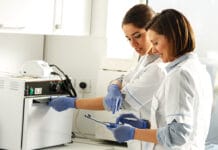Many individuals comprise a dental team in an office, and the professional relationship between the dental hygienist and the dentist – frequently, the employer – should be nurtured. Both dental professionals are pieces of the entire puzzle of a patient’s care. It is crucial to understand what each piece does and recommends to patients, so there will be consistency with a patient’s overall dental care.
Yes, we find out a lot of information through well-documented progress notes. The goal is to have clear, open communication face-to-face as well.
Instruments, Exams, and Treatment Planning
To start things off, especially if you have begun to work in a new office, ask what the doctor’s preferred instruments are that they use during an exam. Do they like a Shepherd’s hook explorer and mirror to be out and ready?
Another key part is figuring out when to call them in for an exam. Would it be more effective to have the doctor in during the appointment (when they are available, they can pop in whenever) or after you are finished? Or, in the current pandemic environment, what is the best, safest way to get a doctor’s exam? These two questions can start the ball rolling. I have asked these two questions very early after accepting a new job, and doctors are very impressed that they are being thought of. These two questions were created when I was first starting out in private practice. I would shadow other hygienists and see what they did. Some would even tell me what the doctor liked and expected.
I enjoy working with my doctor to create a treatment plan for a patient. Performing this strategy forms a cohesive plan, which is extremely important and beneficial for all parties, especially for the patient. During this planning process, you can determine the order of procedures and treatment that needs to be completed. This means figuring out what is the highest priority in regard to a patient’s care. For example, if a patient requires non-surgical periodontal therapy/SRP to decrease gingival discomfort, this would be a higher priority on the treatment plan than a small occlusal restoration, which can be done after that specific quad is scaled.
Sometimes you get those tougher patients who are not in the greatest moods and do not want to cooperate. I can remember when a new patient refused radiographs. Of course, I explained the reasoning behind taking radiographs (an important piece of the whole patient diagnosis) because we did not know the patient’s oral condition. In these situations, I pull in my dentist for support. He reinforces what I recommend and what I previously spoke about. Sometimes the patient needs to hear the information again straight from the boss’ mouth themselves.
Another example is when I had a patient who had not been to the office in 10 years due to dental phobia. She only came into the office as an emergency because her tooth was loose as a result of an injury. After radiographs and exam, I saw that the patient’s teeth were not mobile because of the injury; it was actually due to her advanced periodontal disease.
I called the doctor in so he could do his exam. We then sat with the patient to discuss all our findings. The patient’s treatment plan involved non-surgical periodontal therapy/SRP with local anesthetics, multiple restorations, an extraction due to extensive, active decay, and attempting to stabilize some teeth with bonding.
We would work together to get our patient into a healthier state. I would begin non-surgical periodontal therapy with local anesthetics; then, the patient would return to start some restorative treatment. It was great to be a part of bringing the different dental aspects of the field (restorative and preventive) together. We worked together rather than separate entities who just shared a patient.
Developing Office Values
Team bonding activities or attending continuing education courses as an office are other ways to improve a professional relationship. When everyone gets to know each other a little better outside of the office, it will have a positive effect. Some positive outcomes I have observed are a better work environment (less stressful or hostile), friendliness at the workplace, improved attitudes, more productive appointments, and more trust in each other. Attending a conference or continuing education course can also be a benefit in many different ways, especially when both dental professionals need it to maintain licenses. During the pandemic, this may not be a possibility, however.
As you become more comfortable in the office, you start to identify the dentist’s values. You should also introduce your own values as a dental hygienist. Do you love educating during oral hygiene instruction? Do you have suggestions for their periodontal program? I always say go for it when it comes to positive input in the office. If you see something that you believe can be even better, why not mention it, especially if it comes to helping a patient’s oral health.
An office may sometimes be hesitant at first to changing its ways. I would bring up any concerns to a fellow hygienist or the employer separate from the group. Additionally, I would suggest bringing some evidence to back yourself up with what you want to change or alter in the office. This could be evidence-based research. Another tip could be making these changes slowly, so it is easier to accomplish and avoid overwhelming the office with too much change at once.
Remember, they hired you because they saw something in you. They believe in your professional skills and abilities. Sometimes the patients do the work for you; when the dentist comes in for an exam, the patient expresses how they feel and positive feedback about you to them.
You can also grab the dentist’s attention by showing your abilities by taking the initiative, especially when new to an office, and asking questions. Sometimes, when you are first starting out in the office, you want to blend in with everyone else. Asking questions shows you are interested in learning and that you care. It does not mean you are not intelligent, weak, or do not know what you are doing. Standing out as a professional is not a bad thing! So be yourself and know your worth!
Before you leave, check out the Today’s RDH self-study CE courses. All courses are peer-reviewed and non-sponsored to focus solely on pure education. Click here now.












